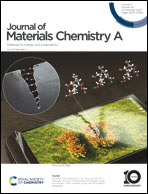Cobalt modification of nickel–iron hydroxide electrocatalysts: a pathway to enhanced oxygen evolution reaction†
Abstract
We present a two-step method for synthesizing high-performing NiFeCo hydroxide electrocatalysts by introducing cobalt into as-synthesized NiFe layered double hydroxide (LDH) using a versatile solution corrosion approach. Our results indicate that cobalt modification significantly reduces the charge transfer resistance, and increases the catalyst turnover frequency, while preserving the integrity of the NiFe LDH layer. With these enhancements, ternary NiFeCo hydroxide obtained an overpotential of 195 mV at 10 mA cm−2, significantly outperforming binary NiFe LDH (264 mV). Additionally, we demonstrate that the choice of metal precursors and their concentrations can greatly impact the morphology and OER performance of NiFeCo hydroxide, particularly in attaining high current densities. Optimizing the precursor concentration is crucial to avoid adverse effects, such as increased charge transfer resistance. The demonstrated performance positions this NiFeCo hydroxide as a promising catalyst for industrial-scale water-splitting applications, highlighting the potential of our modification technique for further development of efficient electrocatalysts.



 Please wait while we load your content...
Please wait while we load your content...